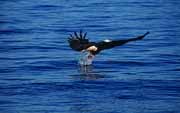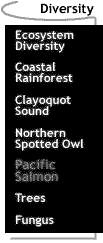 The significance of the coastal temperate rain
forest to salmonids, then, embraces instances in which the fish spend a limited portion of
their freshwater lives there, as well as instances in which salmon complete their entire
life histories in rain forest watersheds. Right: A bald eagle catching a fish to feed newly fledged young. What are the
requirements of an ecosystem to have the salmon and the eagle meet on this day? Photo: Ed Shay
The significance of the coastal temperate rain
forest to salmonids, then, embraces instances in which the fish spend a limited portion of
their freshwater lives there, as well as instances in which salmon complete their entire
life histories in rain forest watersheds. Right: A bald eagle catching a fish to feed newly fledged young. What are the
requirements of an ecosystem to have the salmon and the eagle meet on this day? Photo: Ed Shay
Regardless of the time they spend there, Pacific salmon are a key component of coastal
temperate rain forest ecosystems. They bring nutrients from the marine ecosystem into
terrestrial ecosystems: returning salmon substantially enrich carbon and nitrogen cycles
in the vicinity of spawning areas (Bilby, Fransen, & Bisson
1996). And the salmon's ecological influence extends well beyond the streambank: at
least twenty-two forest-dwelling mammals and birds feed on salmon carcasses (Cederholm, Houston, Cole, & Scarlett 1989). (Nehlsen, & Lichatowich, 1997, pp. 213-214).
"Granted with permission from The Rain Forests of Home, P.K. Schoonmaker, B. von
Hagen, and E.C. Wolf, © Ecotrust, 1997. Published by Island Press, Washington DC and
Covelo, CA. For more information, contact Island Press directly at 1-800-828-1302,
info@islandpress.org (E-mail), or www.islandpress.org (Website)."
Pacific salmon are generally anadromous - they spend a portion of their lives at sea
and return to fresh water to spawn...They begin their lives as newly hatched fry in
headwater streams, in mainstem rivers, or in the mixing zone between coastal estuaries and
freshwater streams, depending on the species. With some species, the young spend only a
few days in fresh water; with others, freshwater residence can last two years or more.
During this period, they feed and try to avoid predators. Their survival depends on
adequate cover to avoid predators and on the quality of the substrate and riparian
vegetation, which are primary sources of food. Survival is diminished by poor water
quality - such as excessive siltation or lethally high water temperatures - or by floods
that wash juveniles with inadequate refuge habitat out to sea.
After rearing in fresh water, juvenile salmon migrate to the sea, most during the
spring and summer. Once they reach the coast, juveniles of some species (especially chum)
feed for a few days or weeks in estuaries before going to sea. The various species of
Pacific salmon remain in the ocean for one to five years. After growing and maturing in
the ocean, adult salmon return to the streams of their birth to spawn. Of the seven
Pacific salmon, only steelhead and sea-run cutthroat trout survive spawning.
Each salmon species has a life history pattern possessing distinctive features such as
age structure, the timing and distribution of spawning within a particular watershed, and
the length of juvenile residence in fresh water." (Nehlsen, & Lichatowich, 1997, pp. 214-215).
"Granted with permission from The Rain Forests of Home, P.K. Schoonmaker, B. von
Hagen, and E.C. Wolf, © Ecotrust, 1997. Published by Island Press, Washington DC and
Covelo, CA. For more information, contact Island Press directly at 1-800-828-1302,
info@islandpress.org (E-mail), or www.islandpress.org (Website)."
All along the Northwest coast, salmon swarm into rivers and creeks to spawn, in places
swimming hundreds of miles inland from the sea. They were an essential resource for
aboriginal people, and their runs were major annual events - with an occasional poor run
foretelling a hungry winter. These red-fleshed fish grow large in the nutrient-rich waters
of the North Pacific, but they spawn in freshwater. There, new generations hatch and, from
their first bite to their last one before entering the sea, they feed on forest nutrients
cycled through a host of aquatic insects in all stages of development. Salmon are a
product of the forest. © 1996. Edwards, Y. British Columbia. In R.
Kirk (Ed.), The Enduring Forests. Seattle: The Mountaineers, p. 125.



